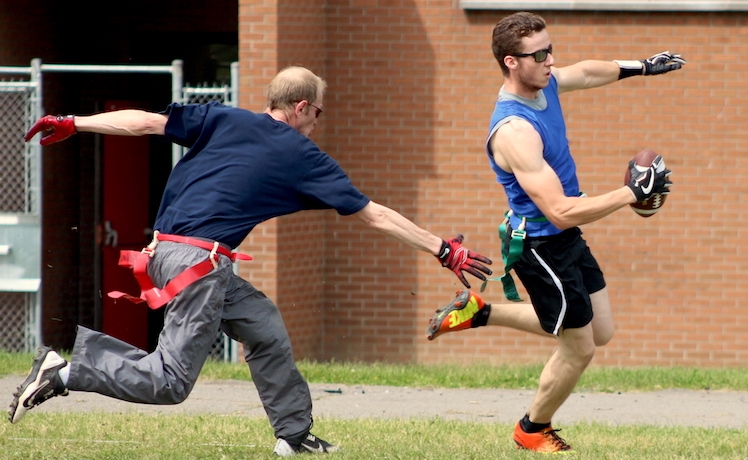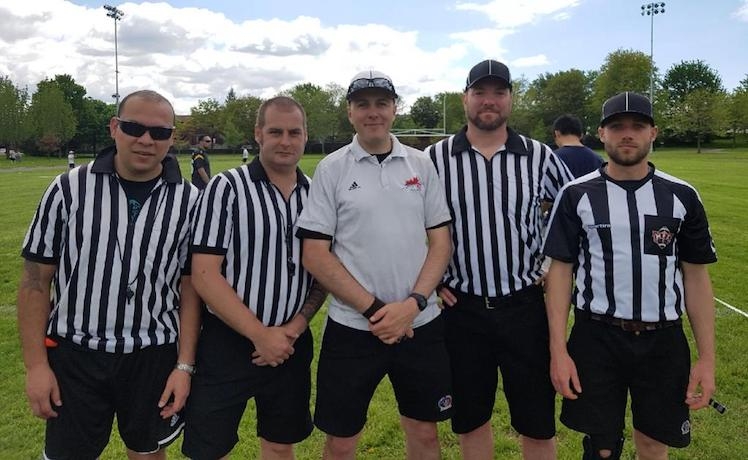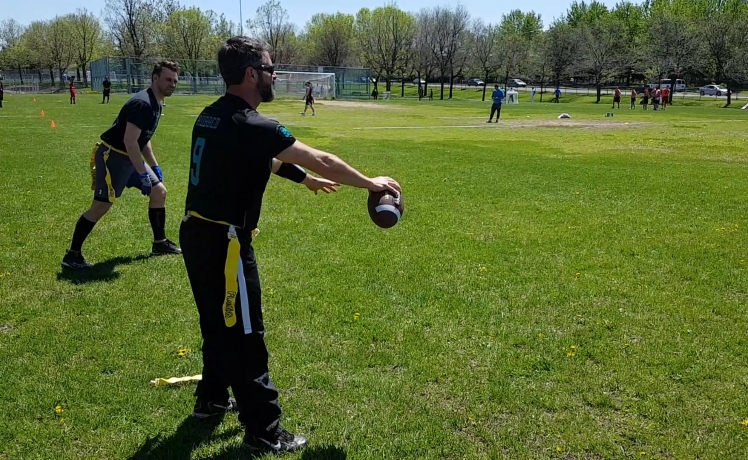
MFL Week 4 in Review
Semaine 4
Bonjour à vous fan de MFL, nous avons eu droit, encore une fois à un excellent week-end de flag-football. D’excellents matchs ont eu lieu, notamment une belle victoire des Krakens sur les Player Haters (33 à 12), un match remarquable des Gros coqs contre le Locomotion (64 à 24), une victoire écrasante des MM contre Team 9 (45 à 0) et la surprise du samedi, une victoire essentielle des Butte Pirates face aux Iron Wolves (40 à 32).
Passons maintenant aux matchs qui ont eu lieu au parc Ignace-Bourget, ceux-ci sont tous aussi captivant et ont donné une idée de ce que les changements de division ont amenés. Bonne lecture!
Division 1
Deep Threats (DT) vs Outlaws
Le samedi commençait avec la rencontre des puissants Outlaws invaincus en trois semaines contre les DT qui s’amenait avec la ferme intention de les mortifiés et d’ainsi prendre leur première victoire de la saison.
Stephen Persaud, quart-arrière des Outlaws a pris quelques minutes pour rapprocher la défensive avec de courtes passes pour finalement rejoindre Meïssa N’Garane sur 28 verges amenant leur premier touché du match. Ryan Shapiro, son homologue du côté des DT à essayer d’en faire autant, mais dès le deuxième jeu, il fût intercepté par Vincent Blondin. La défensive des DT bloqua les Outlaws en 4 jeux alors qu’il leur manquait que 2 verges. La défensive des Outlaws fit de même et DT fût forcé de dégager au quatrième essai.
Les défensives ont continués de donner le ton jusqu’à ce que 2 :27 avant la fin de la demie où Stephen Persaud rejoignit Meïssa N’Garane pour leurs deuxième touché commun. Les DT ont tenté de donner la réplique sans succès et les Outlaws en ont profités pour faire un tour du chapeau de touché, du duo Stephen-Meïssa. Avec quelques secondes au cadran, Ryan Shapiro réussit une belle passe de 17 verges, mais la demie se termina sur un sack performé par Remy Nguyen.
21 à 0 pour les Outlaws, les DT commencèrent à l’offensive et dès le premier jeu, Remy Nguyen continua sur sa lancée en sackant Ryan Shapiro. Les DT furent freiné en 4 essais sans dégager. Stephen Persaud de retour aux commandes fût victime d’un sack d’Aleksander Blostein et ce repris le jeu suivant, en rejoignant Shyanne Stewart pour un touché de 17 verges. Les DT de retour à l’offensive ont fait plus ample connaissance avec le joueur de la semaine : Remy Nguyen a rabattu la passe sur le premier jeu, sacké le quart sur le deuxième jeu et a produit un safety sur le troisième jeu.
C’est trois jeux offensifs plus tard que Stephen Persaud à rejoint ce même Remy Nguyen sur une distance de 42 verges pour un touché. Malgré de beaux efforts des DT, le restant du match se déroula en faveur des Outlaws, avec des interceptions de Meïssa N’Garane et Shyanne Stewart ainsi que des touchés aériens à Shyanne et un autre à Remy Nguyen. La marque finale est de 52 à 0 en faveur Outlaws.
La semaine prochaine, Deep Threats affronteront la récente équipe de division 1, le KOLB et tenteront d’obtenir leur première victoire cette saison. Les Outlaws recevront les Krakens qui semblent inarrêtable depuis deux matchs. Rappelons que ces deux équipes ont croisé le fer à la semaine 2, les Outlaws l’avaient emporté 42 à 13. L’histoire se répètera-t-elle?
Holy Trollers (HT) vs OG Panthers (OGP)
Les Holy Trollers aka Green machine avaient l’honneur d’accueillir les OG Panthers pour leurs première joute en division 1. Les Trollers voulaient oublier leur défaite crève-cœur contre les Krakens de la semaine précédente et les OG Panthers voulaient montrer qu’ils étaient à la hauteur pour la division 1.
La première série offensive appartenait aux HT, dès le premier jeu, Max Rosenfeld fût sacké par Jovi Sciascia, par la suite, Max avança sur le terrain et fût de nouveau sacké, cette fois-ci par le rusher officiel des OGP, qui est bien partie pour une nomination : Terry Babalis. Malgré cette forte défensive, Max à rejoint Josh Levine sur le jeu suivant pour un touché. Charles Duchesne, quart-arrière des OGP commença sa série offensive mais fût intercepter par Kevin Kousaie sur le troisième jeu. Les HT ajoutèrent immédiatement un touché sur le duo Rosenfeld-Levine.
Les OGP n’allaient pas en rester là, sur le premier jeu, Charles décocha une passe de 35 verges à Louis-Mathieu Dufour et deux jeux plus tard, il rejoignit Terry Babalis dans la zone payante. Les HT ont mis 3 minutes pour répliquer sur une troisième passe de touché à Josh Levine. Cette fois-ci, la défense des HT résista à l’attaque des OGP et 4 jeux plus tard, sur un 4ème essai, Max Rosenfeld réussi un autre touché par la passe. Les OGP répliquèrent sur le jeu suivant alors qu’il ne restait que 1 :05, Charles Duchesne rejoignit Louis-Mathieu Dufour sur une distance de 45 verges pour un touché. Les HT utilisèrent toutes les secondes restantes pour produire le dernier touché de la demie.
Mené 33 à 14, les OGP ont commencé la deuxième demie avec la ferme intention de rattraper ce retard. Charles Duchesne à gérer ses troupes de manière grandiose et les amena jusqu’à la zone des buts, mais il fût intercepter par Michael Lesniak. Max Rosenfeld enfila trois passes, dont la dernière de 35 verges pour avoir un autre touché. Les OGP de retour à l’offensive furent rapidement intercepter ce qui mena à un autre passe de touché des HT, cette fois-ci à l’intention de Michael Lesniak.
Alors que les Trollers menaient par la marque de 46 à 14, les OGP dévalèrent le terrain en 3 minutes pour que Charles rejoigne de nouveau l’excellent receveur Louis-Mathieu Dufour. Les HT voulaient boucler la boucle et 3 jeux plus tard, Max Rosenfeld rejoignit Benjamin Bergeron sur 37 verges pour un touché. Avec 1 :52 à faire, les OGP ont tentés de réduire l’écart de point mais sans succès. Marque finale 52 à 20 en faveur des Holy Trollers.
La semaine prochaine, les OGP se prendront contre une des puissances offensives de la division : les Locomotions qui ont perdus leur dernier match, ce match sera très intéressant! Les Holy Trollers rencontreront la puissant Revolucion. La dernière fois que ces deux équipes se sont vues, il s’agissait du quart de finale de la saison d’automne, les Trollers l’avaient emporté par la marque de 33 à 29.
La Revolucion vs KOLB
Pour le premier match en division 1, le KOLB affrontait La Revolucion. Malheureusement, aucun joueur de La Revolucion ne s’est présenté à cette partie. Selon les règles de la MFL, une victoire de 25 à 0 est donc attribuée à l’équipe KOLB. Mais pour cette équipe qui s’est rendu au terrain, voici un cours résumé de leur match face à 5 joueurs des Outlaws et 3 des Old School qui ont acceptés d’être substituts afin que la rencontre est lieu.
Le KOLB a donc commencé à l’attaque et c’est un sack de Remy qui a freiné le KOLB sur leur 4ème jeu. Dès le premier jeu, Jérémi Riendeau-Demers à intercepter Stephen pour redonner le ballon à son offensive et le jeu suivant fût un coiper-coller sauf que cette fois-ci, Shyanne ramena le ballon pour un touché. 6 à 0 pour La Revolucion, Jonathan Plourde, quart-arrière du KOLB a dévalé le terrain jusqu’à la porte des buts où il se fit intercepter par Dahic.
La Revolucion a mis 4 minutes pour que Stephen trouve Yuri dans la zone payante et ainsi inscrire le deuxième touché du match. Deux jeux après, le KOLB subit une deuxième interception de Dahic mais La Revolucion a manqué de temps pour inscrire un autre touché. Fin de la demie, 15 à 0 en défaveur du KOLB.
Stephen repris là où il avait arrêté en première demie et lança son 3ème touché du match dans les mains de Yuri. Le KOLB tenta de répliqué mais un sack de Remy sur un 3ème et 3 verges les força à dégager. La Revolucion changea de quart-arrière pour Shyanne, Alexandre Vallière l’accueilli quelques jeux plus tard avec un sack et Quentin Pha intercepta le ballon pour le ramener en un touché.
La défensive du KOLB maintenant réveillé, stoppa de nouveau La Revolucion avec une autre interception, cette fois-ci par Vincent Thierry Taillefer. Jonathan Plourde continua sur la lancée de en rejoignant Alexandre Vallière pour un touché. Mené 21 à 12 avec 1 :10 à faire au cadran, la défensive du KOLB fît leur possible pour les arrêtés mais le match finit sur une passe de Dahic à Yuri pour un autre touché, amenant le score 27 à 12.
Si l’équipe de La Revolucion est complète, elle jouera samedi prochain contre les Holy Trollers et tenteront de montrer qu’ils ne sont plus la même équipe que l’an passé. Le KOLB affrontera Deep Threat dans un match qui sera enlevant, difficile de savoir qui en sortira vainqueur.
En attendant la semaine 5
Peu importe le terrain, peu importe la semaine, certains joueurs font tout en leur pouvoir pour servir une victoire à leur équipe. Voici ceux qui ont retenus l’attention ce samedi et qui très certainement réitérons leurs exploits la semaine prochaine.
Division 1
Max Rosenfeld – Holy Trollers avec 241 verges par la passe pour 8 touchés.
Robert Prudhomme – Krakens avec 222 verges par la passe pour 5 touchés, 6 plaqués et 5 points de coutures.
Dominique Lefort – Les Gros Coqs avec 175 verges par la passe pour 5 touchés, 2 courses pour 40 verges et 1 touché ainsi que 5 plaqués dont 1 sack et 1 «pick 6».
Division 2
Dylan Moriarity – Brown Machine avec 194 verges par la passe, 4 touchés aériens et 81 verges au sol.
Mauricio Toscano – Iron Wolf avec 23 verges captés, 6 plaqués et 2 interceptions.
Josh Levine – Phantom Troupe avec 176 verges par la passe pour 3 touchés, 71 verges au sol pour 2 touchés et 4 plaqués.




